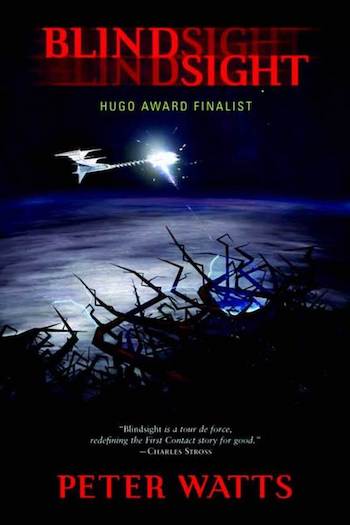Peter Watts’ 2006 novel Blindsight is a hard SF take on first contact, and there are, naturally, some linguistic aspects in the mix, here. Language is not the principal focus of the story, as it is in “Story of Your Life”/Arrival, but it’s a sizeable chunk. A group of bleeding-edge augmented humans led by a resurrected vampire is sent to investigate aliens after a massive number of extraterrestrial probes arrived in a coordinated pattern encircling the globe, first surveying the entirety of the planet in a single scan, then burning up on entry. The job of the astronauts onboard the Theseus is to figure out what the aliens want, and to blow them up if they’re hostile. You know, the usual things people do… I’ve focused on the linguistics-related aspects of the book in this article, since that’s what my column is about; the main plot is not my focus, though I will touch on the parts of it that are necessary to get a better sense of how linguistics function in the novel.
According to the acknowledgements, Watts asked a linguist what she would do in a first contact scenario, and she helpfully responded (her name, Susan James, has been passed on to the fictional linguist that features in the novel). Watts also has a listing of notes and references about the various concepts he used in the text. In the language and linguistics section, he listed several articles from Science, where he said he got the jargon from. Since I still have access to a university library, I pulled the articles up. They’re actually pretty interesting, and one is about whether other primates can learn different types of grammars (phrase structure vs finite state; this type of research is way over my head, and it often leans toward computational. Which is essentially magic for me.) There was even a special section on language in 2004 (Volume 303, starting around page 1300), which didn’t have anything particularly groundbreaking to me, but it’s a good introductory overview of historical linguistics and theories of the origin of language, if you have access to it.
Okay, on to the details: One minor aspect of the linguistics relates to the worldbuilding. Vampires are real and have been resurrected so they can be used in space travel, because they can go dormant. It’s justified in-world and explained in a lot of detail, so I rolled with it. Siri, the narrator, comments on his shipmates’ use of language. The vampire, he notes, does not use the past tense, because he experiences multiple simultaneous worldviews, and thus does not experience the past tense. This is represented in the vampire’s dialogue, and it’s really weird when he’s discussing something in the past using present tense. In English, we rely on tense and adverbials to distinguish time frames, but other languages, such as Yucatec Mayan, use aspect for this. The video I’ve linked to explains aspect better than I can, but the short version is this: aspect can be perfective (completed action) or imperfective (incomplete or ongoing action). This is different from the perfect and imperfect tenses. Grammar! (jazz hands)… Russian is an Indo-European language that uses aspect, which is the bane of people attempting to learn it.
Siri’s frame of the story is that he is narrating it to people back on Earth, and he comments fairly late in the book that everyone on the ship is using multiple languages because “no real scientist would allow their thoughts to be hamstrung by the limits of a single language” (204), and he is translating these into terms the listener/reader would understand. The augmented humans have neural implants that can translate or “subtitle” things for them, which the reader wouldn’t have access to. The quote there is one for which Watts cites an article in Science which suggests that there is no lingua franca in the scientific community, not even English, and states that each of the world Englishes has distinctive features and usages even in their field’s jargon. I’m not sure the quote above on p. 204 captures the same interpretation I would take from the Science article, but code switching is a very real phenomenon. Code switching can be defined roughly as “the use of two (or more) languages by a competent speaker of both languages in a single conversation.” The phenomenon should be held distinct from borrowing, which is a word that is also used by non-bilingual speakers, like “taco” or “zeitgeist.” There are many reasons for a speaker to code switch, and one of them is mentioned in the book. While most of the people on the ship with Siri just use whatever language’s words they want, or throw jargon around like candy, letting the listener comprehend it all through the subtitles from their neural implants, the Theseus‘ linguist Susan James accommodates the listener by modulating her speech and tailoring her word choice to them. (This is something all of us do, even in monolingual situations, when we accommodate to our workplace or to our friends.) Children raised in bilingual households code switch a lot, and it’s normal for them to have vocabulary for one domain, like school, in the school language but not the home language.
Now on to the first contact part. Susan has had her mind partitioned into four distinct personalities and also has “a few dozen unconscious semiotic modules, all working in parallel” (96), because it’s a more efficient use of brainpower than having one personality working on the challenge of communicating with the aliens. I am not a neurobiologist, and I am not going to touch that one; sounds cool, though. They reach the alien vessel and begin communicating with it. Their ship receives a transmission from the alien ship, and Susan decodes it almost instantaneously: “HELLO THESEUS.” As it turns out, the ship is speaking to them in English, using “a chorus of visible light” to communicate. I am skeptical of this, because you need to know what the patterns of light are saying in order to decode what they’re expressing. You can’t start with a bunch of spectrograph data without any idea of what it means and expect to figure it out. (Brute force machine translation and pattern matching could help, but only if your machine already knows both languages.) As we saw in Arrival, you need a Rosetta stone, of sorts. The crew eventually get something like that, however, when two aliens are taken prisoner and Susan runs a lot of cognitive tests on them to determine whether they’re intelligent and sentient.
Buy the Book


Supernova Era
The aliens overheard broadcast transmissions in space, once the radio waves reached them. They observed everything and learned human languages through observation. This is not terribly likely—they had a lot of input, but no interaction. While it’s possible for humans to learn another language through TV and movies, it requires active effort on our parts. Aliens would have no cultural context for anything happening in TV shows, let alone in phone conversations. They would draw conclusions based on their own cultural context—and they could often be wrong. This is a thing that happens in real-world situations, too. Intercultural communication is important, and international businesses often train their employees who will be working with people outside their home culture in aspects of the local culture. A broad example: U.S.-Americans are often loud and straightforward and say things like “yeah, let’s get together sometime” when we don’t mean it. Germans, on the other hand, hear that as an invitation and will be confused when you don’t call them back and invite them out for lunch. So imagine what space aliens, with no preconceived ideas about any human cultures, would get from exposure to The Fonz or Game of Thrones, plus Tumblr, Twitter, and random phone conversations. They would have NO clue what was going on, and no idea how to decipher the sounds they’re hearing.
One of the scientists suggests that the aliens aren’t actually intelligent or sentient, that they’re basically chatbots: responding to stimuli based on similar things they’ve seen and doing pattern matching. They then talk about a Chinese Room, which is basically an algorithm to translate patterns without any comprehension of meaning. Susan, the linguist, uses semantically ambiguous phrases (“our cousins lie about the family tree with nieces and nephews and Neanderthals. We do not like annoying cousins.” (112)) to test whether the aliens truly understand English, or if they’re pattern matching. As the link implies, this is a way to test natural language processing AIs. They don’t recognize the semantic ambiguity, which leads Susan to conclude they’re doing pattern matching. Once they have two alien prisoners, they’re able to get some of the alien language, but even with “all the latest linguistic algorithms” (265), Susan can’t make heads or tails of it. All she knows is that they’re using pigment mosaics to talk, but she can’t decipher the pattern. Thanks to the biologist’s statement that these aliens don’t have genes, they determine that the creatures they have captured aren’t anything more than honeycomb, while their spaceship is the bees.
The aliens communicate through electromagnetic waves, and they use this to determine us-them, kin-enemy relationships. They are highly intelligent, but they have no sense of self, no consciousness per se, which allows them to process information quickly. In essence, the creatures they’ve captured from the alien ship are automata. The alien ship interpreted the human radio communication signals, which are dense and structured, as an attack or a virus, and they want to Deal With It. To the aliens, EM signals come from kin, competitors, or predators, or occasionally, potential allies. The humans’ signals are “needlessly recursive” and “contain no usable intelligence,” despite their intelligent structure. It is “coded nonsense in a way that poses as a useful message” and “consume[s] the resources of a recipient for zero payoff and reduced fitness,” and is therefore an attack (324). The ending of the book is somewhat ambiguous regarding the fate of the aliens and their vessel, as well as Earth.
Being a hard SF book, Blindsight doesn’t stray deeply into strong-Whorfian areas. The closest we come is the part about being hamstrung by a single language, but even that isn’t too out-there. Bilingual speakers code switch for a variety of reasons, and “the word in this language came to mind first” is one of them. The idea of an alien hive-type species who communicates through the EM spectrum and interprets our escaped communications as assault is pretty interesting and cool. When the linguist in the narrative is allowed to do her job and try to communicate with the aliens, she uses reasonably accurate field methods—even if the ability to decode the aliens’ message so quickly seems perilously close to universal translators, which don’t exist (and most likely never will).
CD Covington has masters degrees in German and Linguistics, likes science fiction and roller derby, and misses having a cat. She is a graduate of Viable Paradise 17 and has published short stories in anthologies, most recently the story “Debridement” in Survivor, edited by Mary Anne Mohanraj and J.J. Pionke.










